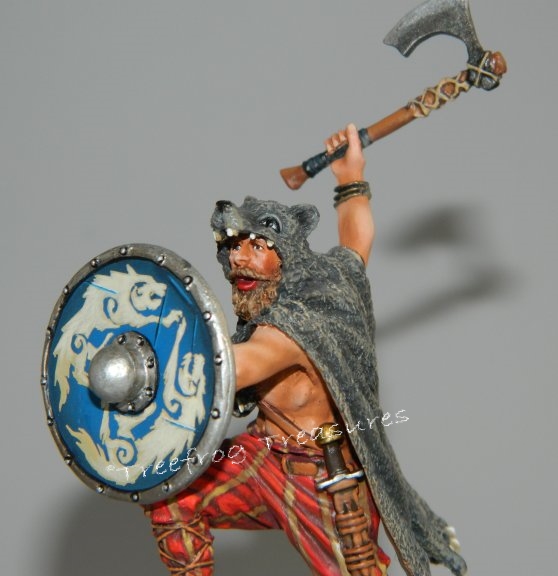- Joined
- Feb 2, 2011
- Messages
- 2,093
NEW RELEASES FOR SEPTEMBER 2020
THE AGE OF ARTHUR
THE NORMAN ARMY
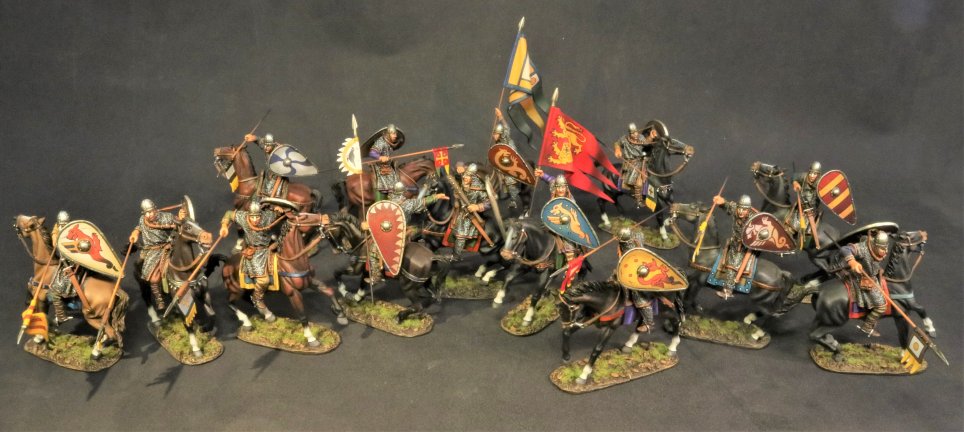
William Duke of Normandy (c. 1028-1087), usually known as William the Conqueror was the first Norman King of England, reigning from 1066 until his death in 1087.
In the 1050’s and early 1060’s, William became a contender for the throne of England held by the Childless Edward the Confessor, his first cousin removed.
There were other claimants. Including the powerful English earl Harold Godwinson, whom Edward had named as King on his deathbed, in January 1066.
William argued that Edward had previously promised the throne to him, and that Harold had sworn to support his claim.
Throughout the summer of 1066, William assembled an army and an invasion fleet in Normandy. This force included, in addition to troops from William’s own territories of Normandy and Maine, large numbers of mercenaries, allies and volunteers from Brittany, Northeast France and Flanders.
The Battle of Hastings took place on the 14[SUP]th[/SUP] October 1066. Although the numbers on each side were about equal, William had the advantage of having both cavalry, infantry and many archers.
Harold had only foot soldiers, and few archers. The English formed a shield wall along a ridge, and were initially so effective that the invading Norman army was repeatedly thrown back with heavy casualties.
Towards the end of the day some of William’s Breton troops panicked and fled, with some of the English troops pursuing the fleeing Bretons. These English troops who had broken ranks, were themselves attacked and destroyed by the Norman mounted knights.
Norman knights were armoured warriors that fought on horseback, with lance , sword and shield. These were the Norman “secret weapon” as nothing like them had been seen before in England. There were between 1,000-2,000 Norman knights in William’s army, and it was these troops which proved decisive to the invading army’s victory.
Two further Norman retreats were feigned, which once again drew the English into pursuit and expose them to repeated attacks by the Norman cavalry.
It appears that the decisive event was Harold’s death, of which there are differing versions which are told.
William of Jumieges claimed that Harold was killed by the Duke himself.
The Bayeux tapestry shows Harold’s death by an arrow to the eye.
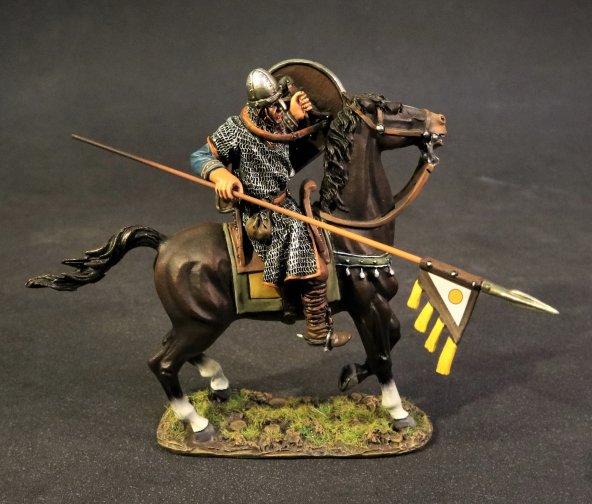
NM-07A
THE AGE OF ARTHUR,
THE NORMAN ARMY,
NORMAN KNIGHT
(3 pcs)
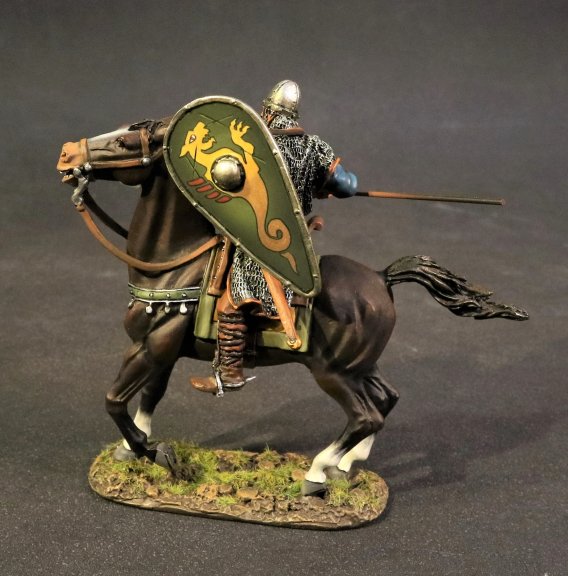
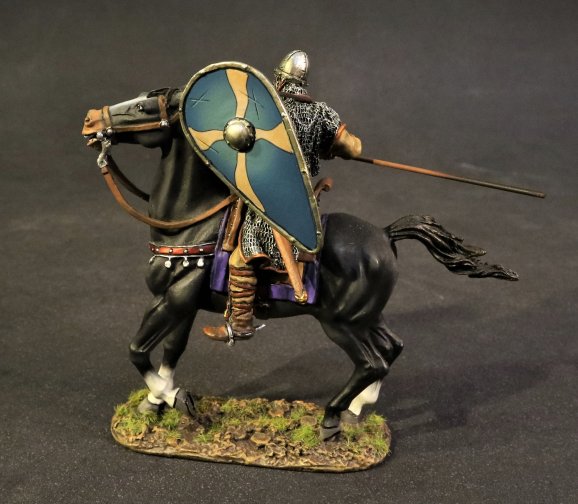
NM-07B
THE AGE OF ARTHUR,
THE NORMAN ARMY,
NORMAN KNIGHT
(3 pcs)
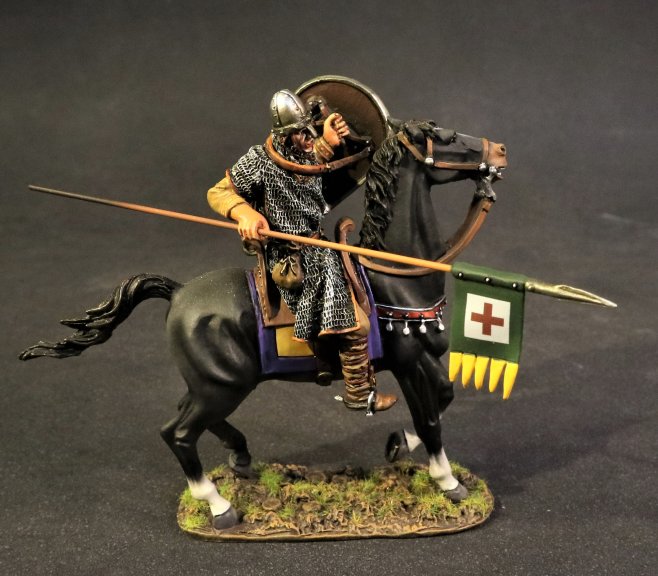
THE VIKINGS
In the Viking world, berserkers were those who were said to have fought in a trance like fury, a characteristic which later gave rise to the modern English word “berserk”, meaning “furiously violent or out of control”.
In battle, the berserkers were subject to fits of frenzy. They would howl like wild beasts, foamed at the mouth, and gnawed the iron rim of their shields. According to belief, during these fits they were immune to steel and fire, and made great havoc in the ranks of the enemy. When the fever abated they were weak and tame. Accounts can be found in the sagas.
When Viking villages went to war in unison, the berserkers often wore special clothing, for instance furs of a wolf or bear, to indicate that this person was a berserker, and would not be able to tell friend from foe when in "bersærkergang". In this way, other allies would know to keep their distance.
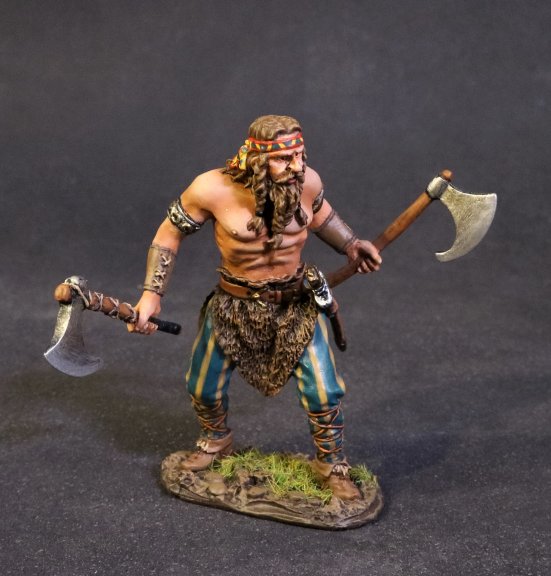
VIK-05
THE AGE OF ARTHUR,
THE VIKINGS,
“BARE-SHIRT” BERSERKER,
(1pc)
The old Norse form of the word was “berserkr”, which likely means “bear-shirt”, or as a thirteen century historian interpreted as “bare shirt”, which could refer to those warriors who went into battle without armour.
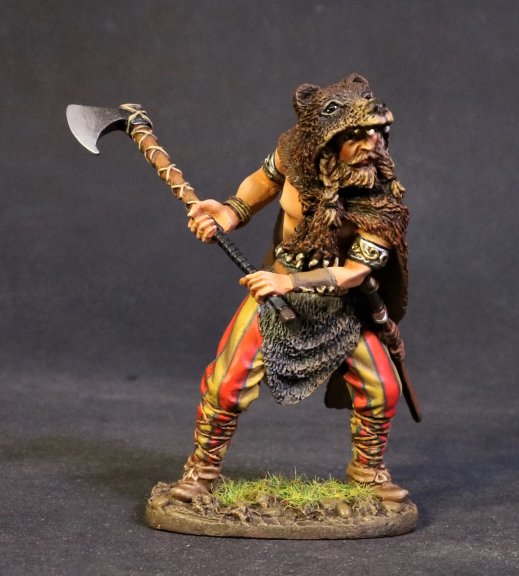
VIK-06
THE AGE OF ARTHUR,
THE VIKINGS,
“BEAR WARRIOR” BERSERKER,
(1 pc)
Other historians reinforce their theory of the “bear shirt” by the fact that it is believed berserkers drew their power from the bear and were devoted to a bear cult, which was once widespread across the northern hemisphere.
The bear-warrior symbolism survives to this day in the form of the bearskin caps worn by the guards of the Danish monarchs.
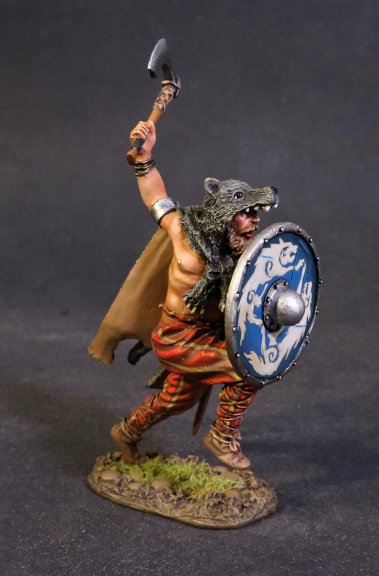
VIK-07
THE AGE OF ARTHUR,
THE VIKINGS,
“ULTHEOMAR” BERSERKER,
(1 pc)
Wolf warriors appear among the legends of many countries. The Germanic wolf warriors have left their trace through shields and standards that were captured by the Romans and displayed in Rome.
The warriors wearing the skins of wolves were actually called “Ulfheonar” (wolf coat), which was another term associated with berserkers.
These warriors were said to wear the pelt of a wolf when they entered battle, and are sometimes described as Odin’s special warriors.
THE CRUSADES
The Crusades were a series of religious wars initiated and often supported directly by the catholic church between the 11[SUP]th[/SUP] and the 17[SUP]th[/SUP] century.
The Crusades differed from other religious conflicts in that they were considered a penance by the participants that brought forgiveness for confessed sin.
In 1095 Pope Urban II proclaimed the First Crusade at the council of Clermont. He encouraged military support for the Byzantine Emperor against the Seljuk Turks, and an armed pilgrimage to Jerusalem.
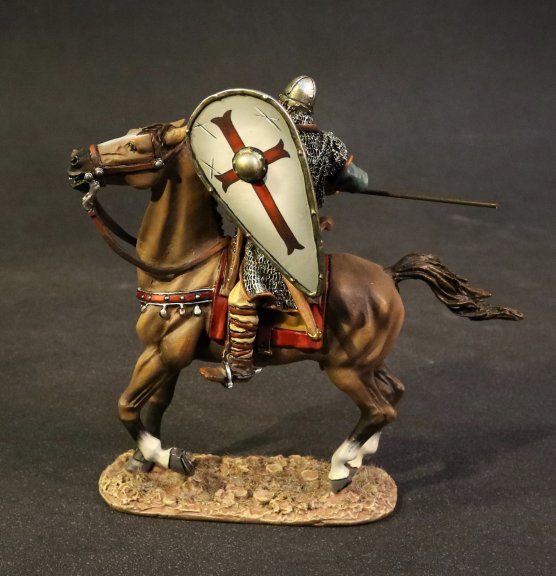
CRU-07
THE CRUSADES,
CRUSADER KNIGHT
(3 pcs)
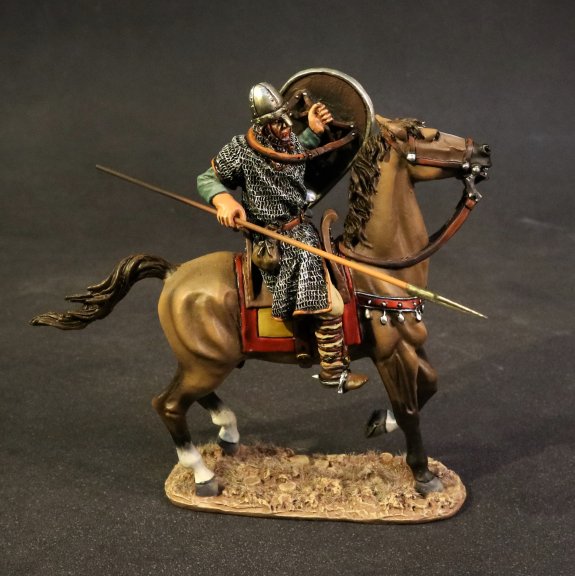
PLEASE CONTACT YOUR LOCAL DEALER FOR FURTHER INFORMATION
THE AGE OF ARTHUR
THE NORMAN ARMY

William Duke of Normandy (c. 1028-1087), usually known as William the Conqueror was the first Norman King of England, reigning from 1066 until his death in 1087.
In the 1050’s and early 1060’s, William became a contender for the throne of England held by the Childless Edward the Confessor, his first cousin removed.
There were other claimants. Including the powerful English earl Harold Godwinson, whom Edward had named as King on his deathbed, in January 1066.
William argued that Edward had previously promised the throne to him, and that Harold had sworn to support his claim.
Throughout the summer of 1066, William assembled an army and an invasion fleet in Normandy. This force included, in addition to troops from William’s own territories of Normandy and Maine, large numbers of mercenaries, allies and volunteers from Brittany, Northeast France and Flanders.
The Battle of Hastings took place on the 14[SUP]th[/SUP] October 1066. Although the numbers on each side were about equal, William had the advantage of having both cavalry, infantry and many archers.
Harold had only foot soldiers, and few archers. The English formed a shield wall along a ridge, and were initially so effective that the invading Norman army was repeatedly thrown back with heavy casualties.
Towards the end of the day some of William’s Breton troops panicked and fled, with some of the English troops pursuing the fleeing Bretons. These English troops who had broken ranks, were themselves attacked and destroyed by the Norman mounted knights.
Norman knights were armoured warriors that fought on horseback, with lance , sword and shield. These were the Norman “secret weapon” as nothing like them had been seen before in England. There were between 1,000-2,000 Norman knights in William’s army, and it was these troops which proved decisive to the invading army’s victory.
Two further Norman retreats were feigned, which once again drew the English into pursuit and expose them to repeated attacks by the Norman cavalry.
It appears that the decisive event was Harold’s death, of which there are differing versions which are told.
William of Jumieges claimed that Harold was killed by the Duke himself.
The Bayeux tapestry shows Harold’s death by an arrow to the eye.

NM-07A
THE AGE OF ARTHUR,
THE NORMAN ARMY,
NORMAN KNIGHT
(3 pcs)


NM-07B
THE AGE OF ARTHUR,
THE NORMAN ARMY,
NORMAN KNIGHT
(3 pcs)

THE VIKINGS
In the Viking world, berserkers were those who were said to have fought in a trance like fury, a characteristic which later gave rise to the modern English word “berserk”, meaning “furiously violent or out of control”.
In battle, the berserkers were subject to fits of frenzy. They would howl like wild beasts, foamed at the mouth, and gnawed the iron rim of their shields. According to belief, during these fits they were immune to steel and fire, and made great havoc in the ranks of the enemy. When the fever abated they were weak and tame. Accounts can be found in the sagas.
When Viking villages went to war in unison, the berserkers often wore special clothing, for instance furs of a wolf or bear, to indicate that this person was a berserker, and would not be able to tell friend from foe when in "bersærkergang". In this way, other allies would know to keep their distance.

VIK-05
THE AGE OF ARTHUR,
THE VIKINGS,
“BARE-SHIRT” BERSERKER,
(1pc)
The old Norse form of the word was “berserkr”, which likely means “bear-shirt”, or as a thirteen century historian interpreted as “bare shirt”, which could refer to those warriors who went into battle without armour.

VIK-06
THE AGE OF ARTHUR,
THE VIKINGS,
“BEAR WARRIOR” BERSERKER,
(1 pc)
Other historians reinforce their theory of the “bear shirt” by the fact that it is believed berserkers drew their power from the bear and were devoted to a bear cult, which was once widespread across the northern hemisphere.
The bear-warrior symbolism survives to this day in the form of the bearskin caps worn by the guards of the Danish monarchs.

VIK-07
THE AGE OF ARTHUR,
THE VIKINGS,
“ULTHEOMAR” BERSERKER,
(1 pc)
Wolf warriors appear among the legends of many countries. The Germanic wolf warriors have left their trace through shields and standards that were captured by the Romans and displayed in Rome.
The warriors wearing the skins of wolves were actually called “Ulfheonar” (wolf coat), which was another term associated with berserkers.
These warriors were said to wear the pelt of a wolf when they entered battle, and are sometimes described as Odin’s special warriors.
THE CRUSADES
The Crusades were a series of religious wars initiated and often supported directly by the catholic church between the 11[SUP]th[/SUP] and the 17[SUP]th[/SUP] century.
The Crusades differed from other religious conflicts in that they were considered a penance by the participants that brought forgiveness for confessed sin.
In 1095 Pope Urban II proclaimed the First Crusade at the council of Clermont. He encouraged military support for the Byzantine Emperor against the Seljuk Turks, and an armed pilgrimage to Jerusalem.

CRU-07
THE CRUSADES,
CRUSADER KNIGHT
(3 pcs)

PLEASE CONTACT YOUR LOCAL DEALER FOR FURTHER INFORMATION


